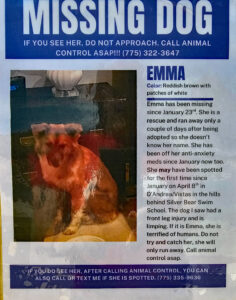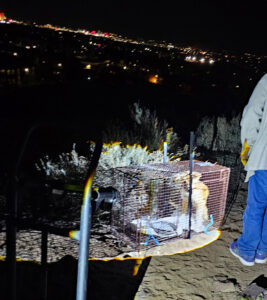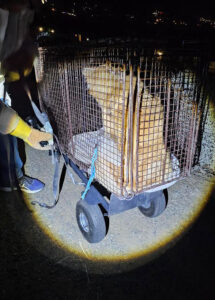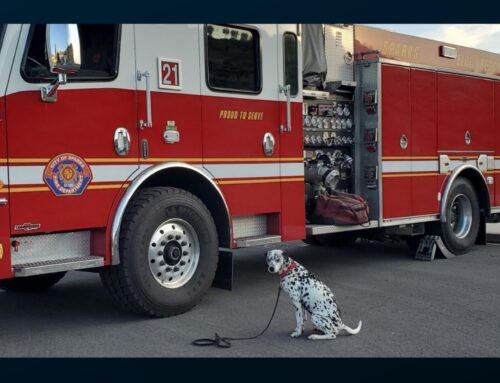Importance of Microchipping
Microchipping your pet is so important if they go missing.
On January 18th, 2025, a beautiful 1-year-old dog was adopted from our local Humane Society. She had just been microchipped and spayed. Her new mom was thrilled to welcome her home. The dog, a stunning golden Australian shepherd mix, weighed about 35 to 40 pounds.
Then, just two days later, on January 20th, the new mom and her pup were enjoying a little time in the backyard when the dog suddenly got spooked and did a spider crawl over their 6-foot fence. This marked the beginning of an almost three-month search for the missing dog.

You often see posters in your neighborhood for lost pets, and we receive alerts on our phones and posts on social media about dogs that have gone missing in the area.
Whether you have had a pet for a long time or are just adding a new one to your home, there are some things we do to keep them safe. Most dogs that are rescued will come with a microchip. It’s important to update the information immediately. If you’re unsure if they are already microchipped, any vet or most rescues can usually scan them to see if they are chipped. If not, check with your local vet or even your local humane society and SPCA to see if they can microchip them. Sometimes you can get it done for free.
Emma’s Story
Now, back to our story of our lost dog. The new owner of the dog (just named Emma) searched high and low. She even talked to people about using a drone to search the nearby desert ravines, she posted on all the local social media apps with a picture of what beautiful Emma looked like, but no luck. It was like she vanished. There had not even been a sighting reported of her.
Just for reference, Emma went missing about a mile and a half as the crow flies from where I live in northern Nevada. Then, on April 9th, just as the sun was starting to set, a couple was walking down the fire lane that runs around the hill next to my home. I live on the side of a hill with a very steep ravine below. They spotted a dog in the desert below as they were walking. They snapped a photo, then tried to go down the ravine to see if they could catch her, but she limped away. It was obvious she was injured and holding up her left front paw, and was very skittish.
They returned the next day, and there she was again. They contacted Animal Control for assistance in trying to catch her. The officer determined she had been living in that ravine for some time. Then they posted on social media sites and the NextDoor neighborhood app with a photo of the dog trying to find the owner. When the owner saw the post, she contacted them immediately. It was her Emma! They started bringing food and water every day for her. Saturday the 12th, Animal Control showed up in front of my house and headed down the ravine to set a trap. This is when I heard of the missing dog. I spoke with the owner and Animal Control to see if I could help.
Around 9 pm later that evening, Animal Control came back and picked up the trap. No Emma…
On Sunday, I spoke with the owner again when she came out to put the food and water out for Emma, and she said she was going to order a trap because Animal Control was not going to come back out to try to trap her. They just didn’t have the resources. She said she couldn’t find a trap large enough in town to trap her.
On Monday, we found out the trap she had ordered would not be delivered until Friday. I contacted a friend in Texas who does a lot of trapping to get some advice. I think I got to know Kacy through our love of Dalmatians and the Dalmatian Rescue of Colorado. She sent out a social media blast to all her trapping community, looking for a trap in our area that we could rent or borrow. But no luck.
Tuesday morning, I got up and took my dalmatian down the fire lane where we sat at the top of the ravine and just talked to Emma as she came out from under the sagebrush where she had been sleeping. I talked to her while she lay licking herself. My boy Chase could see her, but would never chase her. He is much too shy. As we stood up to walk back to my house, I took some video of her limping off through the desert. I knew she needed our help.
The plan to save Emma
When I got home, I recalled that I know some people at Animal Control because I donate Pet Evac Paks to them. They often reach out when they need these packs for demonstrations at events. I thought maybe I could ask them to loan me a trap.
During my conversation with them, I explained that I would take full responsibility for the trap and described how the dog was injured. I assured them that I would stake the trap securely in the ground and point my backyard camera down the ravine to monitor it. They agreed to lend me the trap and even dropped it off that afternoon.
I contacted my friend Kacy again in Texas, and she told me what food to put in the trap and what treats to put up to the trap to lure her in, which also kept the fire ants away. We ran to several stores to get the supplies and called Kathleen, the owner of Emma. She was so excited that we had a plan to try to capture her.
About 7 pm that evening, we headed down the ravine with the trap and all our supplies. We set the trap and drove stakes in the ground next to the trap. Then, zip-tied the trap to the stakes so that if we caught her, she wouldn’t be able to tip it over. With the trap set, we headed home. Next, we pulled down our backyard camera and set it up on the fence so we could watch the trap. It was pretty far away and we didn’t have great vision on it, but you could see enough contrast.
Eyes in the trap

As I lay on my bed watching between the camera on my phone and TV, I started to doze off. Then all of a sudden, I sat straight up in bed. I might have heard the trap door close, or just intuition. I got up and threw on my slippers, and headed out into my backyard, flashlight in hand. It was about 9:30 and pitch black. As I shined the flashlight down the hill, I saw eyes that moved away. I knew there were eyes in the trap. I wasn’t sure if it was a dog or a wild animal.
I came back inside and told my husband we had something in the trap. He headed down the fire lane with the flashlight, and when he came back, he agreed that we had eyes in the trap.
We gathered up our gloves, tools to remove the zip-ties and a dolly that turned into a cart. We knew if we caught her, there was no way we would be able to haul her back up the hill. We had decided we would have to go down the hill through a ditch and up to a gravelled path on the other side to get her out. The cart we could use to set the trap on with her in it to take her down the gravelled path to the road.
As we were heading down the hill, I called Kathleen and told her we had eyes in the trap and to stand by. If it was Emma, she was going to meet us at the end of the trail on the paved road. As we approached the trap and shined the light, to our surprise, it was Emma. After almost 3 months on the run, she was finally safe.
I called Katherine and gave her the good news. Now the hard part was going to be getting her out of that ravine. It took us about 45 minutes through the sagebrush, rocks and darkness, but we rounded the corner and saw Katherine’s headlights; we knew we were close to the end.

When we got her to the car, we could see that she had gotten her leg through her collar and the collar was embedded under her arm and around her neck. We loaded her straight into Kathleen’s car (still in the trap) and she headed straight to the emergency vet.
While this had a happy ending, if someone else had found her or trapped her, the microchip would have helped reunite them.
Emma’s leg was not broken, and the vet had to put her under that night to remove the embedded collar. But now, 2 weeks out, she has the cone of shame off and she is playing ball, sleeping on the couch and doing well.
What is Microchipping?
The procedure involves inserting a tiny chip, about the size of a grain of rice, under the skin, typically between the shoulder blades. The chip contains a unique identification number that can be scanned by vets and animal shelters to retrieve your contact information. The information is then stored in a database using the unique ID number and the information you provide.





